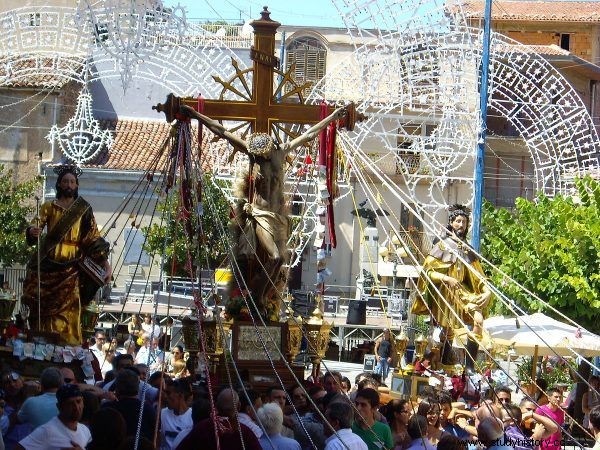With a light hand, they pass death sentences on inconvenient people. Execution is a punishment for disobedience, treason and disloyalty. Or… inappropriate tone of conversation. Single bosses have dozens of victims on their conscience. Can we count them all if they themselves lost count?
Murder is a daily routine for the mafia. The verdict is issued for a number of reasons. Mafiosi kill to punish some, while teaching others. Executions are also a warning to the doubters. They remind who is in charge and show what awaits those who cheat or cheat. After all, as one of the mafia's commandments says: Kill one and you scare ten thousand.
The death penalty is issued by mafia bosses to dishonest partners, disloyal partners and disobedient employees. It also "condemns" incorruptible judges and ... too inquisitive policemen. But this is only the beginning of a long list. As reported in the book "Mafia " German journalist Petra Reski, it happened that the mafias killed their wives' lovers and close relatives. Sometimes people who were completely random also became their victims. Or, for example, hotel owners who have not shown the head of the mafia family the proper respect.
Mafia like a soldier, mafia like a state
The terms "death penalty" or "sentence" do not appear here by accident. Since killing has always been a constant part of the life of members of the mafia, they made a kind of rationalization of it. This is what Petra Reski writes about it:
Murder is not a difficult task for a mafioso. No more difficult than for a soldier, anyway. If Italy started a war with another country and an Italian soldier shot fifty or sixty enemies, he would not be considered a criminal, but worshiped as a war hero. That's what the mafiosi say. Because they consider themselves soldiers who never murder for personal reasons, only for their country and their nation, that is, for the mafia .

The mafia is treated in the south of Italy as the state is treated elsewhere. Consequently, it can sentence any of its enemies to death - even policemen and judges. In the center of the photo one of them - the incorruptible judge Giovanni Falcone (photo:Albertocardillo, license CC BY-SA 4.0).
What a criminal organization is to the world, society, a legal state and nation are to mafiosi. And that's why the mafioso doesn't feel remorse when he kills someone. He is only interested in the judgment of his own people, not strangers. Just like a soldier who fights in the war and who also feels no guilt .
Stew with a wire loop. Or dissolve in acid
The sentences of the criminal "state" are carried out in various ways:by shooting, blowing up or strangling. Italian mafiosi prefer the latter method, because everything then takes place without noise and without blood. This is how an execution of this type is described in Petra Reska's book "Mafia", one of the mafias, Marcello Fava:
Usually the victim is taken home by a friend, possibly her best friend, to make her feel safe. Then one grabs her and if she has anything else to say, this is the right time. I would like to see one who, having a noose around his neck, will not say anything. But whether he says it or not, he will be killed anyway.

Usually three people participate in the action. Two hold the victim, and the third strangles him, most often with a wire loop. Strangling your hands is considered too bothersome. Those who do not need additional props and murder by themselves gain a lot of fame among their own. One of them was Salvatore "Toto" Riina.
"Short Toto", as the boss was called, gained recognition in the underworld, especially after the murder of a prominent member of the Sicilian mafia, Rosaria Riccobona, nicknamed "Saruzzo". Saruzzo, your story is over - he said to his victim one day, at the end of a heavily wine-drenched dinner. And he tightened his hands around Riccobon's neck while two other mafiosi held down the defenseless man. Riina strangled his victim in less than three minutes.
Toto's brutality was enormous even by mafia standards. Among other things, he massacred almost the entire family of the former boss Tommaso Buscetta. He killed almost all of his close relatives:brother, son-in-law, brother-in-law, four nephews and nephews, and two sons.

Salvatore "Toto" Riina is a brutal man, even by mafia standards (public domain).
The Mafia treats its verdicts not only as a tool of justice, but also as a warning to others. This is why the deceased is left with marks on the body telling him why he was liquidated. If his eyes were torn out, he has seen too much . If his ears were cut, he heard too much. If he had his genitals removed he would be advocating someone else's wife or daughter, and if a cross had been cut out of his mouth he would talk too much.
The piety of murderers
There are even more macabre crimes. Petra Reski gives the example of a man who was strangled, after which his head was cut off, castrated and the severed genitals were put into his mouth. Another "convict" had his arm cut off before he was killed. The Mafia also does not shy away from killing women (even pregnant ones!) And children. A terrible fate befell the thirteen-year-old Giuseppe di Matteo, the son of an ex-mafioso who collaborated with the justice system. The boy was kidnapped and kept in a dungeon for two years, where he was starved and tortured. Eventually he was strangled and dissolved in acid.
Can such ruthless actions be reconciled with any kind of religiosity at all? Mafiosi didn't have any problems with it. As Petra Reski describes, one of them, before each murder, lit a candle in front of the statue of Jesus and prayed: Jesus Christ, take it! Take it to you! . It was only when God did not listen to his requests that the mafioso took the matter into his own hands and committed the murder himself. Then he would go back to praying, saying: Dear God, you didn't want him, but I sent him to you .

The religiosity of Sicilians is expressed, inter alia, in participating in richly framed religious processions. No one is bothered by the fact that sacred figures are almost always worn by members of the mafia, and the celebrations are usually funded by mafia money. The photo shows a procession in the Sicilian Galati Mamertino (photo:Kyioko, license CC BY-SA 4.0).
The murderer, Leoluca Bagarella, also went to church before each murder. God, only you alone know they want to be killed themselves. I am not to blame - he prayed.
How many victims were there?
How many people actually murdered the Italian mafia? The answer to this question is not easy. The Mafia is a closed structure where silence and discretion are valued above all else, and traitors are punishable by death. Information is leaked out rarely and very difficult to obtain. We simply do not know about some of the murders, and some are not confirmed. Researchers wishing to determine the number of victims are therefore reliant on adding up the reported cases and estimating the probable ones.
Fabrizio Calvi, author of the book "Everyday Life of the Mafia from 1950 to Our Days", estimates that the mafia could have killed as many as 30,000 people since the end of the 19th century . The victims were members of rival families, officials, judges, prosecutors, policemen, carabinieri ... but also priests and random people.

In turn, the French historian Marie-Anne Matard-Bonucci, author of The History of the Mafia, estimates the balance of the victims of the Italian mafia (in all its varieties) more carefully, at 15-20 thousand people. An even smaller number is given by the Italian researcher Pierluigi Bredo. He believes that mafia families have killed around 12,000 people in over a century.
It is a bit easier to identify mafia victims in more recent times, because we have police statistics. We know, for example, that from 1981 to 1990 there were 12,116 homicides in Italy. Three-quarters of them took place in the southern regions of the country, where the mafia is most active. Most in Sicily - 2905. In Campania, 2621 people were killed during this time, in Calabria - 1807 and 757 in Apulia. Criminal organizations were the perpetrators of these murders in over 70 percent of the cases.
The death toll decreased significantly over the next decade. According to a global UN report, the number of mafia-related killings in Italy between 1992 and 2012 was 3,575.

Have you messed up with the mafia? If so, then planting a bomb under a car is one of the "pleasant" things that await you. Perhaps the last one in my life ... Photo from the mafia attack in Palermo in 1982 (public domain).
Accused of a thousand kills
The scale of the mafia killings may be frightening. It is enough to realize that during the great war of Sicilian families in Palermo between 1981-1983, an average of one man was murdered a day. And these were not just members of quarreling families. Also judges, prosecutors and policemen were victims of the games.
Personal Mafia records are also impressive. One of the top bosses in Sicily, Michele Greco, known as the Pope ( il Papa ), handed down hundreds of death sentences. The already mentioned Salvatore Toto Riina, known as the Beast, reportedly killed about 40 people himself. The police charged him with a total of 1,000 murders. It was he who "condemned" the anti-Mafia judges Giovanni Falcone and Paolo Borsellino to death.
The issue of the number of victims killed by the mafia is cynically summarized by Camorra Antonio Iovine. A longtime boss turned to the side of the judiciary. His testimony in court, especially concerning the relations between politicians and mafia circles, repeatedly shocked the Italian public opinion. This was also the case in 2014, when Iovine told the court that during his mafia career he had committed so many murders that he does not remember all of them ...
Buy cheaper on Empik.com:

